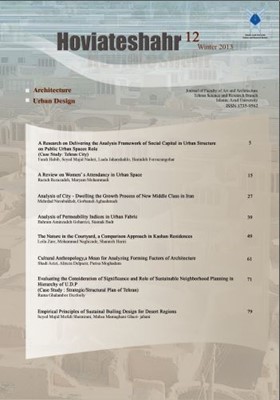Analysis of Permeability Indices in Urban Fabric
Subject Areas : architectureBahram AminzadehGoharrizi 1 , Siamak Badr 2
1 - Assistant Professor, Faculty of Architecture and Urbanism, Imam Khomeini International University, Qazvin, Iran
2 - M.S. Candidate, Dept. of Urban and Regional Planning, Faculty of Architecture and Urbanism, ShahidBeheshti University, Tehran, Iran.
Keywords:
Abstract :
Permeability is one of the basic concepts of contemporary theories ofurban planning and design which as a qualitative index (in some aspects) has taken a great attention in decisions of urban planners. However a more connected (Permeable) road system provides a great number of route options and provides more direct routes but it is arguable that permeability is not always a good quality of urban fabric. A great number of samples can be found in historic cities of Iran that for defensive purpose or for cultural/religious reasons, permeability is intentionally decreased as shown in samples of article from Old Semnan City. In Iranian cities also assessing this measurement (permeability) has a great role in defining decays in urban spaces and an index is used for it. Reviewing literature on the nature of this concept (not only in urban planning and design field but in general) shows that what has been used in defining permeability is not pervasive. As a response to this deficient definition and index for measuring permeability, this article has reviewed and represented some other measurements (including Intersection density, Street Density, Connected Node Ratio, Link Node Ratio, Gamma Index and Alpha Index) that has been used around world as response to pedestrian safety, decreasing emergency services time, etc. Finally application of them in a sample urban fabric is showed. Many of these indices are based on the simulating urban street pattern to a planar graph and so some principles of graph theory (Like Euler Theory) is applied in order to define the best and worst samples. But looking at urban fabrics shows some differences in these two, so based on these differences Gamma (Ratio of the number of links in the network to the maximum possible number of links between nodes) and Alpha (Ratio of the number of actual circuits to the maximum number of circuits) Indices are reviewed and a new form of them is proposed. Finally for measuring permeability, a combination of three indices of Distance of parcel to the first entrance of district, adjusted gamma and alpha indices and Distance to first intersection is proposed. For applying this method to a sample urban fabric, the number of calculation for each parcel will decrease enormously. So a procedure for programming (automation) in GIS is proposed which makes this method in some aspects dynamic. Data and Informationfor applying in this procedure can be collected from roads network layer of each city and parcels in land use maps. Based on this, decision makers can modify both indices and proposed alternatives by considering the outcomes of the process. For the purpose of testing this procedure a sample of Tehran city which is located in southern part of it and as a historical area suffer from permeability problem, is selected and each index is assessed in it and then using the method proposed in this article an intervention process is proposed in the area and finally it is reassessed which shows whether the intervention is efficient or not.
_||_

